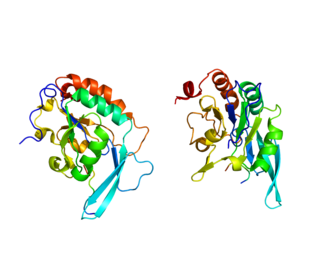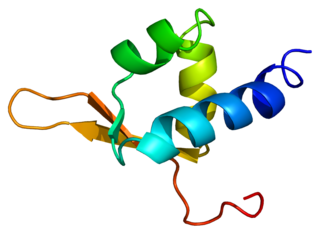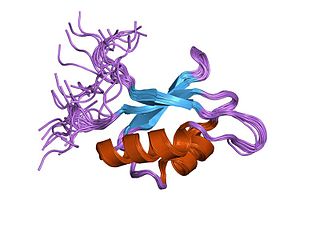
Transcription is the process of copying a segment of DNA into RNA. The segments of DNA transcribed into RNA molecules that can encode proteins are said to produce messenger RNA (mRNA). Other segments of DNA are copied into RNA molecules called non-coding RNAs (ncRNAs). mRNA comprises only 1–3% of total RNA samples. Less than 2% of the human genome can be transcribed into mRNA, while at least 80% of mammalian genomic DNA can be actively transcribed, with the majority of this 80% considered to be ncRNA.

Wolf–Hirschhorn syndrome (WHS) is a chromosomal deletion syndrome resulting from a partial deletion on the short arm of chromosome 4. Features include a distinct craniofacial phenotype and intellectual disability.

RNA polymerase II is a multiprotein complex that transcribes DNA into precursors of messenger RNA (mRNA) and most small nuclear RNA (snRNA) and microRNA. It is one of the three RNAP enzymes found in the nucleus of eukaryotic cells. A 550 kDa complex of 12 subunits, RNAP II is the most studied type of RNA polymerase. A wide range of transcription factors are required for it to bind to upstream gene promoters and begin transcription.

A capping enzyme (CE) is an enzyme that catalyzes the attachment of the 5' cap to messenger RNA molecules that are in the process of being synthesized in the cell nucleus during the first stages of gene expression. The addition of the cap occurs co-transcriptionally, after the growing RNA molecule contains as little as 25 nucleotides. The enzymatic reaction is catalyzed specifically by the phosphorylated carboxyl-terminal domain (CTD) of RNA polymerase II. The 5' cap is therefore specific to RNAs synthesized by this polymerase rather than those synthesized by RNA polymerase I or RNA polymerase III. Pre-mRNA undergoes a series of modifications - 5' capping, splicing and 3' polyadenylation before becoming mature mRNA that exits the nucleus to be translated into functional proteins and capping of the 5' end is the first of these modifications. Three enzymes, RNA triphosphatase, guanylyltransferase, and methyltransferase are involved in the addition of the methylated 5' cap to the mRNA.

Eukaryotic transcription is the elaborate process that eukaryotic cells use to copy genetic information stored in DNA into units of transportable complementary RNA replica. Gene transcription occurs in both eukaryotic and prokaryotic cells. Unlike prokaryotic RNA polymerase that initiates the transcription of all different types of RNA, RNA polymerase in eukaryotes comes in three variations, each translating a different type of gene. A eukaryotic cell has a nucleus that separates the processes of transcription and translation. Eukaryotic transcription occurs within the nucleus where DNA is packaged into nucleosomes and higher order chromatin structures. The complexity of the eukaryotic genome necessitates a great variety and complexity of gene expression control.

The positive transcription elongation factor, P-TEFb, is a multiprotein complex that plays an essential role in the regulation of transcription by RNA polymerase II in eukaryotes. Immediately following initiation Pol II becomes trapped in promoter proximal paused positions on the majority of human genes. P-TEFb is a cyclin dependent kinase that can phosphorylate the DRB sensitivity inducing factor (DSIF) and negative elongation factor (NELF), as well as the carboxyl terminal domain of the large subunit of Pol II and this causes the transition into productive elongation leading to the synthesis of mRNAs. P-TEFb is regulated in part by a reversible association with the 7SK snRNP. Treatment of cells with the P-TEFb inhibitors DRB or flavopidirol leads to loss of mRNA production and ultimately cell death.

DNA-directed RNA polymerase II subunit RPB1, also known as RPB1, is an enzyme that is encoded by the POLR2A gene in humans.

Transcription elongation factor SPT5 is a protein that in humans is encoded by the SUPT5H gene.

FACT complex subunit SSRP1 also known as structure specific recognition protein 1 is a protein that in humans is encoded by the SSRP1 gene.

HIV Tat-specific factor 1 is a protein that in humans is encoded by the HTATSF1 gene.

Negative elongation factor E is a protein that in humans is encoded by the RDBP gene.

FACT complex subunit SPT16 is a protein that in humans is encoded by the SUPT16H gene.

Cofactor of BRCA1, also known as COBRA1, is a human gene that encodes NELF-B.

Transcription elongation factor SPT4 is a protein that in humans is encoded by the SUPT4H1 gene.

Probable histone-lysine N-methyltransferase NSD2 is an enzyme that in humans is encoded by the NSD2 gene.

Negative elongation factor C/D is a protein that in humans is encoded by the TH1L gene.

General transcription factor IIF subunit 2 is a protein that in humans is encoded by the GTF2F2 gene.

5,6-Dichloro-1-β-D-ribofuranosylbenzimidazole (DRB) is a chemical compound that inhibits transcription elongation by RNA Polymerase II. Sensitivity to DRB is dependent on DRB sensitivity inducing factor (DSIF), negative elongation factor (NELF), and positive transcription elongation factor b (P-TEFb). DRB is a nucleoside analog and also inhibits some protein kinases.

In molecular biology, the NELF is a four-subunit protein complex that negatively impacts transcription by RNA polymerase II by pausing about 20-60 nucleotides downstream from the transcription start site (TSS).
Chromosomal deletion syndromes result from deletion of parts of chromosomes. Depending on the location, size, and whom the deletion is inherited from, there are a few known different variations of chromosome deletions. Chromosomal deletion syndromes typically involve larger deletions that are visible using karyotyping techniques. Smaller deletions result in Microdeletion syndrome, which are detected using fluorescence in situ hybridization (FISH)























